10 Most Sustainable Summer Clothing Brands: The Conscious Consumer’s Guide
Affiliate Disclosure
Hey fellow impactful ninja ?
You may have noticed that Impactful Ninja is all about providing helpful information to make a positive impact on the world and society. And that we love to link back to where we found all the information for each of our posts.
Most of these links are informational-based for you to check out their primary sources with one click.
But some of these links are so-called "affiliate links" to products that we recommend.
Why do we add these product links?
First and foremost, because we believe that they add value to you. For example, when we wrote a post about the environmental impact of long showers, we came across an EPA recommendation to use WaterSense showerheads. So we linked to where you can find them. Or, for many of our posts, we also link to our favorite books on that topic so that you can get a much more holistic overview than one single blog post could provide.
And when there is an affiliate program for these products, we sign up for it. For example, as Amazon Associates, we earn from qualifying purchases.
What do these affiliate links mean for you?
First, and most importantly, we still only recommend products that we believe add value for you.
When you buy something through one of our affiliate links, we may earn a small commission - but at no additional costs to you.
And when you buy something through a link that is not an affiliate link, we won’t receive any commission but we’ll still be happy to have helped you.
What do these affiliate links mean for us?
When we find products that we believe add value to you and the seller has an affiliate program, we sign up for it.
When you buy something through one of our affiliate links, we may earn a small commission (at no extra costs to you).
And at this point in time, all money is reinvested in sharing the most helpful content with you. This includes all operating costs for running this site and the content creation itself.
What does this mean for me personally?
You may have noticed by the way Impactful Ninja is operated that money is not the driving factor behind it. It is a passion project of mine and I love to share helpful information with you to make a positive impact on the world and society. However, it's a project in that I invest a lot of time and also quite some money.
Eventually, my dream is to one day turn this passion project into my full-time job and provide even more helpful information. But that's still a long time to go.
Stay impactful,
Amid growing concerns about the textile industry’s environmental impact, there is pressure to find greener clothes for your wardrobe, whether for the coldest or the warmest weather. Unfortunately, fashion greenwashing makes it harder for you and other consumers to figure out which clothing brands offer the most eco-friendly garments for the hot summer days. So, we had to ask: Which are the most sustainable summer clothing brands?
The most sustainable summer clothing brands are Christy Dawn, Vitamin A, and éclipse, which prioritize low-impact recycled materials, reduce carbon emissions, and fight the climate crisis. The Classic T-Shirt Company and All the Wild Roses also minimize textile waste and follow ethical practices.
Whether you are searching for a breathable T-shirt or a colorful dress for your next summer holiday without negatively impacting the soil, the water, the animals, and other people, there is a brand for you. So, let’s keep reading to learn more about the most sustainable summer clothing brands and how they ensure sustainable, ethical practices.
Here’s How We Selected the Most Sustainable Summer Clothing Brands
The fast fashion industry has pushed for summer clothing items to be trend-dependent and easily replaceable. Yet, the environmental impacts of making and landfilling clothes can be enormous, especially with certain materials.
“Sustainable: The ability to be maintained at a certain rate or level | Avoidance of the depletion of natural resources in order to maintain an ecological balance”
Oxford Dictionary
The brands on this list were chosen based on their commitment and actions to promote sustainable practices while reducing the environmental impacts of the textile industry.
They are transparent about their materials, processes, and workforce management within their supply chain.
Some brands focus their efforts on reducing waste and optimizing natural resources while others strive to reduce the carbon footprint of their clothes.
All of these brands share the commitment to reshape the textile industry toward a more sustainable and Earth-friendly sector.
These Are the 10 Most Sustainable Summer Clothing Brands
Most Sustainable Summer Clothing Brands
Overall, these summer clothing brands are sustainable. Yet, they take various approaches to reduce environmental impacts and uphold ethical standards. Let’s dive into each brand and find out more.
Christy Dawn: Vintage-Inspired Summary Dresses Made With Deadstock and Organic Fabrics

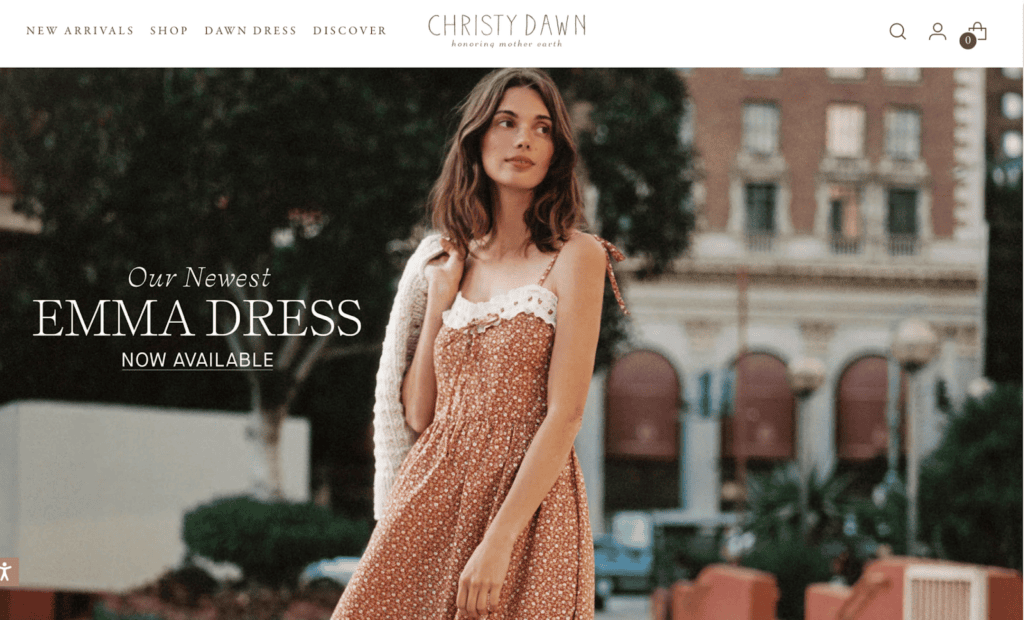
“We forge mutually beneficial relationships with all of the people and ecosystems we work with, from the farm and weavers in India to dressmakers and photographers in Los Angeles.”
Christy Dawn
🌎
How do they ensure their sustainability?
Christy Dawn ensures sustainability by sourcing eco-friendly materials, making long-lasting products, and offsetting their carbon emissions.
- They use a high proportion of low-impact textiles, including deadstock fabrics, organic cotton, and regenerative cotton. By diverting deadstock fabrics (velvet, wool, fleece, and leather) away from landfills and into their dresses, tops, and shoes, they lower their carbon footprint while reducing textile waste.
- Additionally, Christy Dawn sources cotton from a regenerative farm, harvesting the fibers and renourishing the land. The Christy Dawn × Oshadi Farm is a collaboration that increases the solid health and biodiversity of 219 acres of land and addresses climate change by drawing down more than 2 million tons of carbon from the atmosphere.
- Further down the life-cycle in the manufacturing stage, Christy Dawn opts for construction techniques that enable them to produce high-quality, timeless pieces that consumers can wear for a long time, reducing the impact of owning clothes. Regarding their climate impact, Christy Dawn eliminates, captures, or mitigates all of the carbon emissions created from manufacturing and shipping their products via their partnership with EcoCart.
- Lastly, they partner with ThreadUp to give pre-loved clothes the best possible chance at a second life, extending textile lifespans and reducing the overall environmental impacts of owning various items of clothing.
🌐
How do they ensure their ethics?
Christy Dawn traces their supply chain and ensures that some of their suppliers pay living wages.
🤝
Are they part of any giving-back programs?
Christy Dawn is not known to be part of any giving-back programs.
🛍️
What is their product range?
- Best for: womenswear
- Product range: dresses, knitwear, outerwear, jackets, tops, blouses, bottoms, loungewear, jumpsuits, overalls, shoes, plus-size accessories
- Price range: $$$
- Size range: XS–3XL
Vitamin A: Sustainably Made Swimwear and Beachwear for a Summer by the Sea
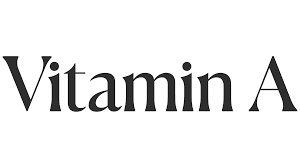

“We focus on the intersection of flawless fit, high quality, continuous innovation, and elegant designs… Every one of our pieces is designed by women, for women.”
Amahlia Stevens, founder of Vitamin A
🌎
How do they ensure their sustainability?
Vitamin A ensures their sustainability by sourcing recycled synthetic materials for their products and manufacturing them locally using low-impact technologies.
- They use recycled nylon in place of virgin nylon to create fabric blends for their bikinis, swimsuits, and beachwear lines, saving 77% water usage. The brand also incorporates sustainable natural fabrics and high-performing plant-based textiles into their products, including GOTS-certified organic cotton, linen, recycled cotton, and TENCEL™. All materials used by Vitamin A are certified to meet the global OEKO-TEX® STANDARD 100 for safe textiles. On top of that, the majority of their swimwear is crafted locally in Californian vertically integrated facilities (and the rest in the US), reducing the transporting carbon footprint.
- Regarding production, they use mostly digital printing, which requires less water and creates less fabric waste than traditional wet printing.
- Other measures used at their headquarters and warehouse to reduce their environmental footprint include all paper products made with 100% recycled post-consumer waste, no disposable plastic water bottles, a heat reclamation system, and working-from-home support to avoid unnecessary travel.
🌐
How do they ensure their ethics?
Vitamin A ensures their ethical and responsible production by keeping production locally in California, which has the strictest environmental laws in the nation. They also visit their factories regularly to ensure employees are being treated and paid fairly and that the working conditions are clean and safe.
🤝
Are they part of any giving-back programs?
Vitamin A is a proud member of 1% for the Planet. They give back to organizations that work to protect the oceans. Additionally, they host beach cleanups.
🛍️
What is their product range?
- Best for: womenswear
- Product range: swim tops, swim bottoms, beach tops, beach bottoms, one-pieces, dresses, rompers, shirts, pants, overalls, hoodies, shorts, accessories
- Price range: $$
- Size range: XS–XL
éclipse: UPF 50+ Clothing for a Sunny Summer

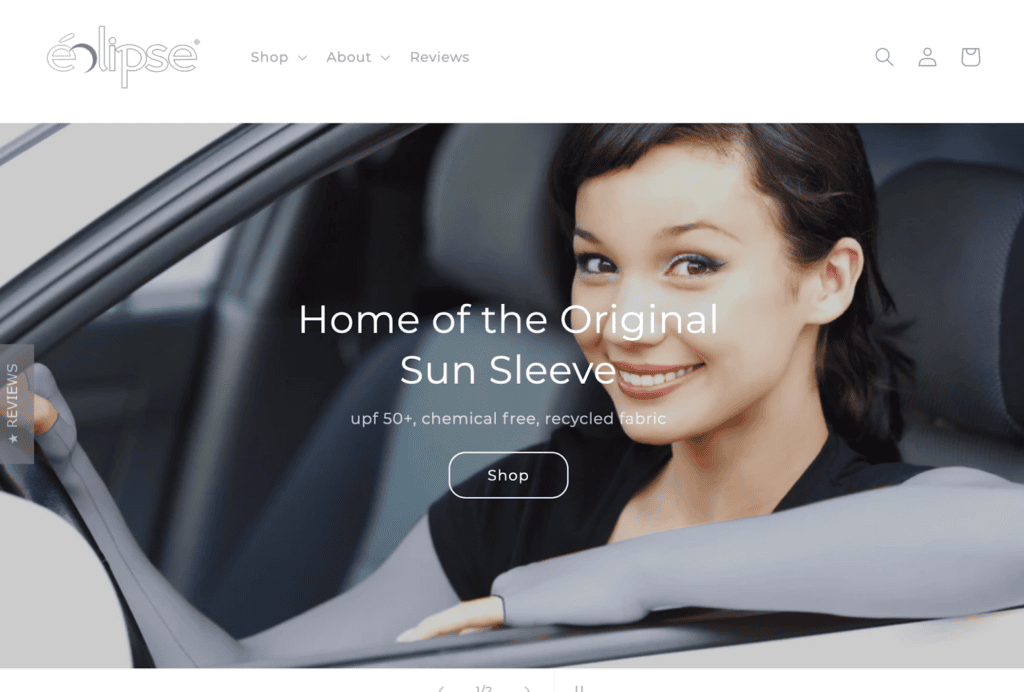
“Eclipse uses high-tech, UPF 50+ (maximum sun protection) thermoregulating (temperature control) fabric to keep you cool and recycled fabric (from plastic bottles) to minimize environmental impact. All products are made in the USA with the highest environmental and worker protection standards.”
éclipse
🌎
How do they ensure their sustainability?
éclipse promotes sustainability by sourcing low-impact textile and packaging materials, reducing textile waste, and keeping their carbon footprint low.
- Firstly, they use a medium proportion of recycled fabrics to lower the impact of using functional synthetic materials. Specifically, the brand has been transitioning to recycled polyester across all styles, aiming to offer the same fit and feel as their thermoregulating 37.5™ fabric. Additionally, they work with a Bluesign®-certified partner to transition to compostable packaging and shipping materials.
- Secondly, éclipse minimizes textile waste by operating on limited production runs and taking back used éclipse apparel to keep them in circulation longer and out of landfills.
Lastly, the brand manufactures locally in the US to reduce transport carbon emissions.
🌐
How do they ensure their ethics?
éclipse traces most of their supply chain. Their Supplier Code of Conduct also covers four of the ILO’s Fundamental Principles and Rights at Work.
🤝
Are they part of any giving-back programs?
éclipse plants a tree with every order.
🛍️
What is their product range?
- Best for: menswear, womenswear
- Product range: hoodies, sweatshirts, T-shirts, accessories
- Price range: $$
- Size range: S–L
The Classic T-Shirt Company: Organic Cotton T-Shirts Made in the US
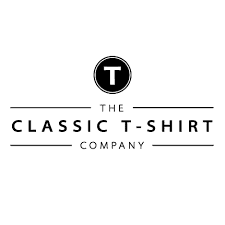
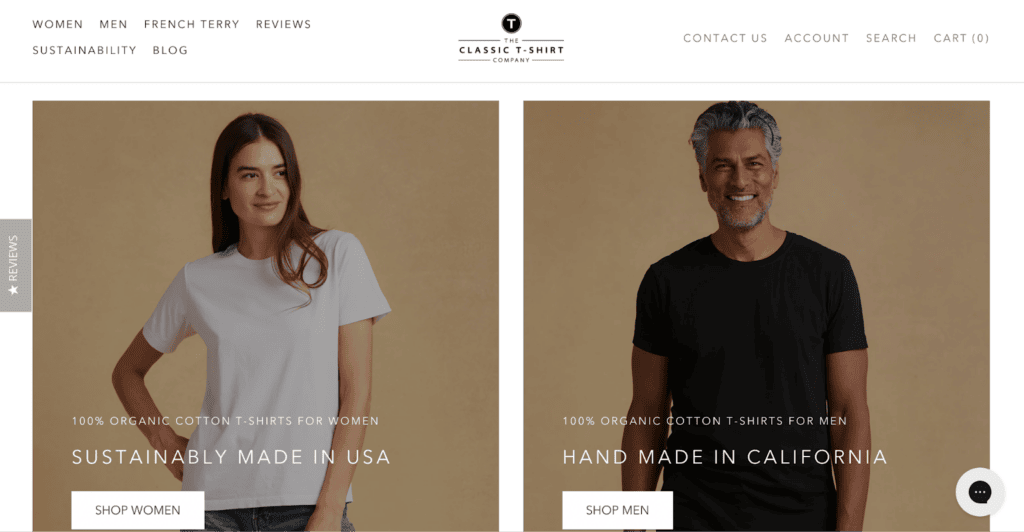
“The Classic T-shirt company was founded to shake up the fashion industry by creating ethically made luxury fashion items, starting with a full range of Organic Cotton T-shirts for men and women that we couldn’t be prouder of.”
The Classic T-Shirt Company
🌎
How do they ensure their sustainability?
The Classic T-Shirt Company ensures their sustainability by sourcing eco-friendly materials and producing locally.
- Firstly, they use a high proportion of organic cotton cultivated organically in India according to the Global Organic Textile Standard (GOTS). For example, their women’s Short Box Tee Crew Neck T-shirt is made with 100% organic cotton. Furthermore, The Classic T-Shirt Company is committed to plastic-free shipping. All their orders are sent in 100% recycled and recyclable packaging.
- Secondly, they produce locally in California to reduce their carbon footprint.
🌐
How do they ensure their ethics?
The Classic T-Shirt Company holds their final production stage in Los Angeles, California. They also pay living wages to all of their workers.
🤝
Are they part of any giving-back programs?
The Classic T-Shirt Company pledges 1% of their equity, profit, and time to causes they believe in, including safe water, tree planting, and ocean cleanup. The brand supports changemakers like Water for People, the Armenia Tree Project, and The Ocean Cleanup.
🛍️
What is their product range?
- Best for: menswear, womenswear
- Product range: short-sleeve T-shirts, long-sleeve T-shirts, pants, shorts
- Price range: $$
- Size range: XS–XXXL
All the Wild Roses: Timeless Bohemian Clothing Made With Upcycled and Vintage Fabrics


“From designing to our making process, our intention & focus is to create timeless designs that last, to do it in a way that minimises our environmental footprint and to do it with care & respect for our community (including and not limited to our makers, suppliers, customers and more).”
All the Wild Roses
🌎
How do they ensure their sustainability?
All the Wild Roses ensures sustainability by reducing textile waste; sourcing biodegradable, plastic-free materials; and lowering their carbon footprint.
- Their waste reduction incentives include sourcing deadstock fabrics, limiting production runs, and making clothes to order. By curating deadstock, surplus, or remnant fabrics into making their clothes, they help reduce the amount of textile waste in landfills. All the Wild Roses also makes up to 90% of their collections with upcycled fabrics. To further minimize textile waste, they run limited batches of clothes, making the most of the upcycled fabrics they find while offering made-to-order service to avoid unnecessary inventory.
- Regarding textile materials, they prioritize biodegradable fibers derived from nature, including upcycled linen, cotton, and rayon. Furthermore, their packaging is compostable and plastic-free.
- Lastly, they have incentives to lower their carbon footprint, including using 100% renewable and carbon-neutral energy for their design office, offsetting their operations with GreenFleet (a non-profit dedicated to restoring Australian Forest), opting for a carbon neutral shipping service, and operating 100% online which uses about 30% less energy than traditional retail
🌐
How do they ensure their ethics?
All the Wild Roses has a formal statement covering workers’ rights. They ensure payment of a living wage in the final stage of production. Additionally, they trace their supply chain and visit their suppliers.
🤝
Are they part of any giving-back programs?
All the Wild Roses partners with Opportunity International Australia to provide microloans to women-led businesses in developing countries.
🛍️
What is their product range?
- Best for: kidswear, menswear, womenswear
- Product range: dresses, jumpsuits, tops, skirts, maternity dresses, breastfeeding dresses
- Price range: $$
- Size range: XXS–XXL
Altar: Customized US-Made Clothes From Deadstock Fabrics

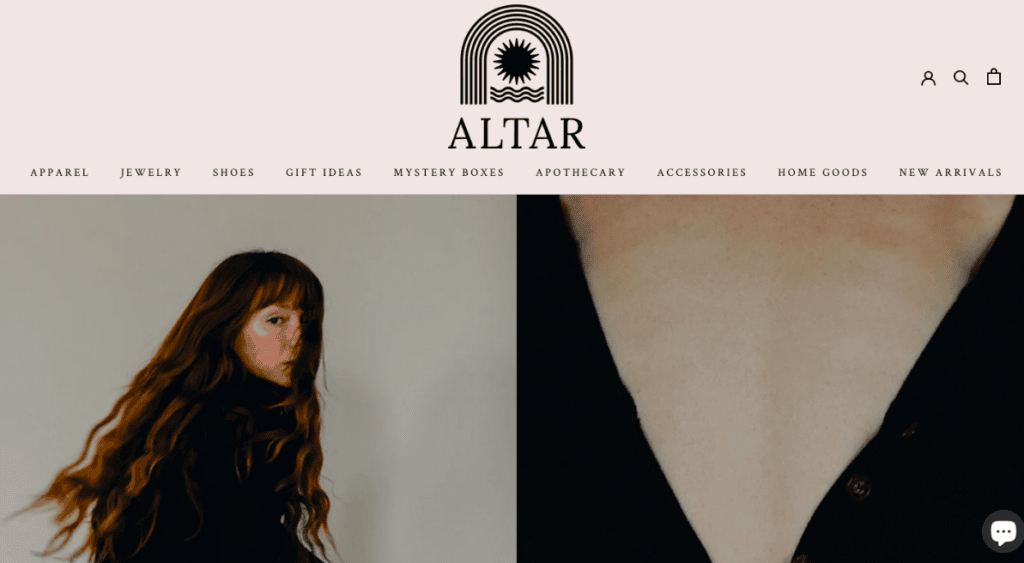
“Our store is committed to diversity and inclusivity: in our hiring practices, our product sourcing, our visual content, and our core values.”
Altar
🌎
How do they ensure their sustainability?
Altar ensures sustainability by sourcing a high proportion of deadstock fabrics, particularly breathable plant-derived fibers (lyocell, modal, and viscose) for their apparel, taking made-in-order and zero-waste approaches to production to reduce waste, and extending the garment’s life-cycle with their repairing service and their platform selling pre-loved clothes.
- In addition to using deadstock fabrics, Altar further reduces textile waste by operating small made-to-order runs, making the most of their material while avoiding large inventory. They also utilize their scrap fabric to create small accessories as well as One-Of-A-Kind Zero-Waste garment pieces, keeping textile waste, synthetic fabrics in particular, out of landfills. For unusable scraps, they recycle using ReTold Recycling. Beyond textiles, Altar commits to sustainable sourcing of packaging materials, using compostable mailers, gift boxes, bags, and tissues from Noissue, Packwire, Rio Grande, and Papermart.
- They also reuse bubble wrap from received orders when necessary.
- Additionally, their partnership with Treet and Recovo enables closing the circle of waste on both ends of their production.
- Lastly, Altar produces apparel locally in the US, reducing the transporting carbon footprint.
🌐
How do they ensure their ethics?
Altar traces most of their supply chain, including the final stage of production undertaken in the US. Additionally, they commit to diversity and inclusivity. Their working practices and clothing production represent the diversity of body types, gender, race, and cultural identities. Examples of these ethical practices are the size gradations up to 6XL, increased sourcing from BIPOC (Black, Indigenous, and People of Color) manufacturers, and an Afterpay option to lessen some barriers to entry on price points.
🤝
Are they part of any giving-back programs?
Altar partners with Greenspark to contribute to environmental projects, including planting trees, collecting plastics, and offsetting carbon emissions. For example, for every purchase made of Altar apparel, they rescue 10 plastic bottles from the ocean. They also contribute to various charities, including but not limited to Black Lives Matter, Doctors for Global Health (DGH Foundation), Reclaim the Block, Don’t Shoot PDX, and Palestine Children’s Relief Fund.
🛍️
What is their product range?
- Best for: womenswear
- Product range: dresses, tops, bottoms, sweaters, rompers, swimwear, underwear, shoes, accessories, plus size
- Price range: $$$$
- Size range: S–6XL
peony: Carbon-Neutral Luxury Swimwear Made From Repurposed Waste


“Our approach is to create consciously, engage in ongoing reflection and continually drive progress towards sustainability, circularity, inclusivity and transparency..”
peony
🌎
How do they ensure their sustainability?
peony ensures their sustainability by sourcing eco-friendly materials for textiles and packaging while reducing plastic waste.
- Specifically, their swimwear main fabrics and linings are created in-house with recycled content, which includes REPREVE® yarn made from 100% recycled plastic bottles and ECONYL® yarn, a 100% regenerated nylon fiber made from nylon waste that would otherwise pollute the earth, such as fishing nets, fabric scraps, and carpet flooring. So far, their use of recycled swimwear fabrics has diverted approximately 104,975 lbs of post-consumer waste from landfills. For their resort wear, the brand also sources low-impact fabrics, including GOTS-certified organic cotton, European Flax®-certified linen, EcoVero®—a responsibly sourced viscose yarn made by Lenzing with EU Ecolabel‘s stamp of approval, recycled polyester, and hemp. Linen and organic cotton accounted for the largest percentages of fibers in their 2022 resort wear collection: 37% and 35%, respectively. peony also opts for low-impact packaging, using only recycled, compostable, and reusable materials. Their orders are wrapped in recycled, compostable, and FSC-certified tissue paper and sent in mailer bags made from waste, using only renewable solar power—no water, acid, or bleaches. Their garment components include swing tags made from recycled and FSC-certified wood, swimwear hygiene liners made from FSC-certified wood-based bioplastic, and compostable and biodegradable bags for bikini straps.
- Secondly, peony designs for circularity, which means that garments are made to be worn, reused, and recirculated for as long as possible. They achieve that by sourcing the highest quality fabrics and using construction techniques that extend the life of each garment. The brand also aims to create pieces that transcend seasons so you can use them in your wardrobe season after season. When a piece is at the end of its life, peony will take it back for responsible reuse or recycling.
- Lastly, all of peony’s printed fabrics are digitally printed, reducing fabric waste and water consumption.
🌐
How do they ensure their ethics?
peony traces most of their suppliers. Their manufacturing partners for swimwear and resort wear hold internationally recognized certifications, including BSCI, SA8000, and OEKO-TEX®.
🤝
Are they part of any giving-back programs?
peony donates excess stock and samples to Worn for Good, a social enterprise devoted to social and environmental change and the movement toward a circular economy. They also partner with Thread Together on an ongoing basis, donating “end-of-the-line” new clothing to people in their community. Some other causes supported by peony include the Queensland Paediatric Oncology Ward and the Australian Bushfire.
🛍️
What is their product range?
- Best for: womenswear
- Product range: swimwear tops, swimwear bottoms, bikinis, coverups, dresses, tops, skirts, pants, accessories
- Price range: $$$
- Size range: XS–3XL
Harvest & Mill: Carbon-Neutral Apparel Made in Organic and Traceable US-Based Supply Chain
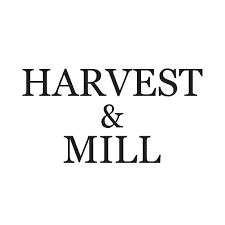
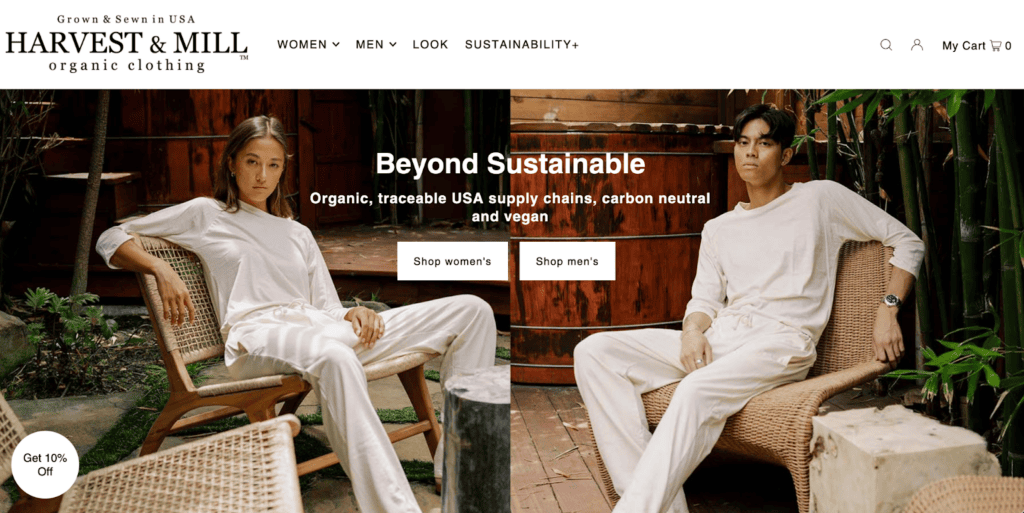
“We use zero fabric wholesalers or brokers and we use only 100% USA grown organic cotton yarns – because that is the only way to have true transparency in fashion and fabric chemical content.”
Harvest & Mill
🌎
How do they ensure their sustainability?
Harvest & Mill’s sustainability efforts focus on using low-impact materials, minimizing textile waste, and achieving carbon neutrality.
- Firstly, they source eco-friendly materials, from fibers to dyestuff to packaging. In particular, they source a high proportion of organic cotton, grown and milled in the US, for their socks, bottoms, and tops. They also opt for low-impact, natural, and non-toxic dyestuff for some of their apparel while eliminating dyes altogether for their sock collection, their Organic Heirloom Brown Collection, and all their natural-white joggers and tops.
- Regarding packaging and shipping, Harvest & Mill uses plastic-free, reusable, recyclable, and easily compostable materials. Secondly, they minimize textile waste by designing patterns that reduce off-cuts while repurposing or recycling all extra fabrics.
- Thirdly, they achieve carbon neutrality by reducing and offsetting their emissions. Beyond that, they hold their supply chain entirely in the US, shortening the transporting distances (by five times).
- And lastly, they offset all their carbon emissions, including production, supply chain transportation, office operation, and all orders they ship out.
🌐
How do they ensure their ethics?
Harvest & Mill traces their whole supply chain and visits their suppliers regularly. They state that from the farm workers to the factory workers, everyone who works on Harvest & Mill clothing receives a fair wage, safe working conditions, the legally protected right to organize, and protection from discrimination.
🤝
Are they part of any giving-back programs?
Harvest & Mill is a member of Fibershed, a nonprofit that develops regional fiber systems that build soil and protect the health of Earth’s biosystems.
🛍️
What is their product range?
- Best for: womenswear, menswear
- Product range: shirts, T-shirts, pants, shorts, socks
- Price range: $$$
- Size range: S–XL
Neu Nomads: An Ethic-First Brand With a Commitment to Sustainability and Traceability


“We always consider how to create something beautiful with the lowest possible impact on the world.”
Karen Wood, founder of Neu Nomads
🌎
How do they ensure their sustainability?
Neu Nomads prioritizes sustainability by opting for eco-friendly materials, using renewable energy in their supply chain, and reducing waste with a platform to resell and reuse pre-loved clothes.
- Their biodegradable, plant-based fabrics include linen, certified organic cotton, and TENCEL™ (lyocell fabrics produced by Lenzing).
- Furthermore, their factory in India is powered by solar energy, with all the excess energy directed back to the local community. Water used for dying fabrics is captured, purified, and processed using non-toxic and AZO-free dyes.
- Lastly, nearly 90% of the water used during dyeing is recycled in a common effluent treatment plant.
🌐
How do they ensure their ethics?
Neu Nomads ensures their ethics through fair labor practices and transparent supply chains. They also make regular inspection visits to their suppliers. On top of that, 85% of their garments are produced in a family-owned factory in Delhi that maintains healthy working conditions, healthcare benefits, and compensation far above the living wage.
🤝
Are they part of any giving-back programs?
Neu Nomads is not known to be part of any giving-back programs.
🛍️
What is their product range?
- Best for: luxurious essential clothing items for female modern travelers
- Product range: shirts, scarves, dresses, pants, jackets, blazers, knitwear, tops, blouses, T-shirts, lingerie
- Price range: $$$
- Size range: XXS–XXL
Passion Lilie: Fair Trade Dresses Made With Natural Fibers

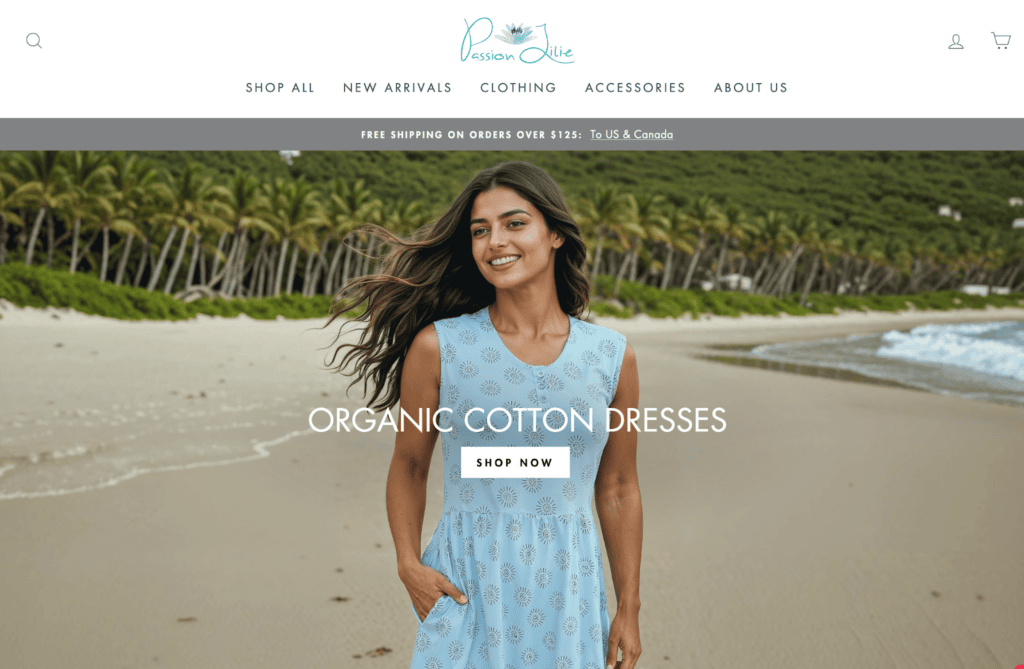
“At Passion Lilie, we believe in making things the right way. We care deeply about doing our part to build a more sustainable world, one built on honesty and respect. From the way we design to the way we create each fair trade collection, sustainability is at the core of every aspect of our business.”
Passion Lilie
🌎
How do they ensure their sustainability?
Passion Lilie ensures their sustainability by sourcing low-impact textiles and dyestuff.
- Firstly, they prioritize durable natural fibers, specifically organic cotton and recycled cotton.
- Secondly, their fabrics are colored with sustainable dyes, including GOTS-certified organic dyes and azo-free synthetic dyes. Their artisans also hand-paint some garments using all-natural elements such as fruits, leaves, bark, and vegetables found locally in India.
- In addition, Passion Lillie strives to lower their climate impact by sourcing raw materials close to their manufacturing facilities, using non-mechanical manufacturing processes—ikat weaving, hand block printing, hand washing—and purchasing carbon offset credits to compensate for the shipping from their Indian factories to their US base and to their customers.
🌐
How do they ensure their ethics?
Passion Lilie traces most of their supply chain.
- They use the Fair Trade Federation‘s (FTF) screening process as a guideline for establishing relationships with new partner groups, ensuring that the selected manufacturing partners employ fair trade practices, including paying a living wage.
- Furthermore, Passion Lilie provides their artisan partners with opportunities for community development and to further their skills.
🤝
Are they part of any giving-back programs?
Passion Lilie offers Indian artisans three-month free training to advance their skills and increase their earning potential.
🛍️
What is their product range?
- Best for: womenswear, menswear
- Product range: dresses, button-down shirts, tops, bottoms, accessories, home
- Price range: $$
- Size range: XS–XXL
Why Is It Important to Buy Products Made of More Sustainable Fabrics
It is important to buy products made of more sustainable fabrics because a sustainable textile industry has a lower carbon footprint, helps save natural resources, and is better for forests, animals, and humans.
Buying Sustainable Fabrics Reduces Your Carbon Footprint
The production of clothing and footwear is estimated to contribute 10% of global greenhouse gas emissions—more than all international flights and shipping combined. If the fashion industry were a country, it would be the fourth largest emitter of carbon dioxide.
One way to reduce the carbon footprint of the clothes you buy is to opt for sustainable fabrics. Sustainable fabrics, which are often made with natural or recycled fibers, have relatively low carbon footprints compared to petroleum-based fabrics. For example, organic cotton made in the US has a carbon footprint of 2.35 kg CO2 (per ton of spun fiber)—a quarter of polyester’s carbon footprint.
Buying Sustainable Fabrics Reduces Demand for Natural Resources and Waste Management
The textile industry uses water and land to grow cotton and other fibers. It is estimated that 79 billion cubic meters of water were used for the sector worldwide in 2015. For example, producing a single cotton T-shirt requires as much water as one person drinks for 2.5 years (2,700 liters of fresh water).
Worse yet, the textile economy is vastly more linear than circular: the largest amount of resources used in clothes ended up in landfill (instead of being recycled to remake clothes). According to a report by the Ellen MacArthur Foundation,
- Less than 3% of materials used in the textile economy in 2015 came from recycled sources.
- In other words, more than 97% of resources used in making clothes are newly extracted.
When clothing items are disposed of within a short period of time—under a year in the case of half of the fast fashion clothes—the natural systems that provide raw materials for fabrics don’t have enough time to recover and regenerate, which could lead to ecological breakdown.
Sustainable fabrics are made with less water and emissions while lasting longer:
- Because they are durable, you don’t need to buy new clothes too often.
- Thus, you help reduce the pressure to extract more resources for making new items.
Similarly, making and consuming sustainable fabrics made with recycled materials reduces the demand for virgin materials while helping tackle waste management.
Buying Sustainable Fabrics Encourages Sustainable Management of Forests
Sustainable natural fiber fabrics are made with raw materials from forests and plantations that are sustainably managed, such as complying with FSC standards.
When you buy sustainable natural fiber fabrics, you discourage unsustainable forestry practices like illegal logging. You can help reduce deforestation, biodiversity loss, and the effects of climate change.
Buying Sustainable Fabrics Encourages Fairer Treatment of Animals
The fashion industry is rife with animal mistreatment when it comes to making animal-based fabrics like wool or silk. Every year, billions of animals suffer and die for clothing and accessories.
Buying sustainable vegan alternatives can help to reduce the pressure on raising more and more animals to meet the demand for animal-based fabrics while sacrificing their well-being and lives.
Suppose you have to buy fabrics made with, for example, wool or silk; make sure you only choose brands committed to cruelty-free products. In that case, you help advocate better treatments for animals raised within the textile industry.
Using Sustainable Fabrics Encourages Fairer Treatment of Textile Workers
Recent statistics from UNICEF estimated as many as 170 million child laborers worldwide, many of whom were engaged in some form of work in the textile industry. They don’t get paid minimum wages and often work long hours.
When you buy sustainable fabrics from brands transparent about the working conditions at their factories, you discourage the use of child labor and help promote better working conditions for textile workers.
How Can You Generally Buy More Sustainable Fabrics
The key to sustainably buying fabrics is to check on relevant environmental and original certifications.
For natural fabrics:
- Global Organic Textile Standard (GOTS): A globally recognized certification system that ensures a certain threshold of organic content has been met. It covers manufacturing, packaging, labeling, transportation, and distribution (but not what happens in the fields where crops are grown).
- USDA Certified Biobased Product: The USDA BioPreferred® Certification is a voluntary certification offered by the United States Department of Agriculture. The certification identifies products made from plants or other renewable materials.
- Ecolabel: Ecolabel is the official Canadian Union voluntary label recognized worldwide for certified products with a guaranteed, independently verified low environmental impact. The label requires high environmental standards throughout the entire life-cycle: from raw material extraction through production and distribution to disposal. It also encourages companies to develop innovative, durable, easy-to-repair, and recyclable products.
For natural fiber semi-natural/semi-synthetic fabrics:
- Forest Stewardship Council: An FSC certification ensures that the wood (or wood-like material) comes from responsibly managed forests that provide environmental, social, and economic benefits.
There are two types of FSC Certification:- FSC Forest Management Certification, with a focus on the origin of the wood—the forest.
- FSC Chain of Custody Certification, which focuses on the path from the forest to the customer’s home.
- Program for Endorsement of Forest Certification: PEFC’s approaches to sustainable forest management are in line with protecting the forests globally and locally and making the certificate work for everyone. Getting a PEFC certification is strict enough to ensure the sustainable management of a forest is socially just, ecologically sound, and economically viable but attainable not only by big but small forest owners.
For recycled fabrics:
- Recycled Claim Standard (RCS): The Textile Exchange RCS was originally developed as an international, voluntary standard that sets requirements for third-party certification of Recycled input and chain of custody.
- The Global Recycled Standard (GRS): The Global Recycled Standard (GRS) is an international, voluntary, full product standard that sets requirements for third-party certification of Recycled Content, chain of custody, social and environmental practices, and chemical restrictions. It can be used for any product with more than 20% recycled material.
For all types of fabrics:
- STeP by OEKO-TEX®: STeP by OEKO-TEX® is an independent certification system for brands, retailers, and manufacturers from the textile and leather industry. It communicates organizational environmental measures, including reducing carbon footprint and water usage.
- OEKO-TEX® Standard 100: OEKO-TEX® labels aim to ensure that products pose no risk to human health (i.e., containing banned chemicals).
Some certifications that are signaling brands’ efforts toward lowered environmental impacts and a circular economy are:
- B Corp Certification: The label B Corp is a certification reserved for for-profit companies. Certified holders are assessed on their social and environmental impacts.
- Cradle2Cradle certification: Cradle2Cradle provides a standardized approach to material circularity. It assesses whether products have been suitably designed and made with the circular economy in mind covering five critical categories: material health, material reuse, renewable energy and carbon management, water stewardship, and social fairness.
Final Thoughts
The fast fashion industry has pushed for many summer clothing items to be trend-dependent and easily replaceable. Yet, the environmental impacts of making and landfilling clothes can be enormous, especially with certain materials. Thus, it is important to shop with ethics and sustainability in mind when choosing your next item of summer clothing.
By purchasing summer clothes from brands that commit to sustainability, you support their mission to create a fairer and less harmful textile industry for all lives on Earth.
Here is the list (again) of the most sustainable summer clothing brands:
- Christy Dawn
- Vitamin A
- éclipse
- The Classic T-Shirt Company
- All The Wild Roses
- Altar
- peony
- Harvest & Mill
- Neu Nomad
- Passion Lilie
To make your use of these summer clothing items even more sustainable, follow these steps:
- Buy second-hand, recycled, or upcycled clothes made with low-impact materials.
- Keep your clothes for as long as possible.
- At the end-of-life of your clothes, upcycle the materials to extend their usage and arrange for them to be recycled or properly disposed of.
Stay impactful,

Sources
- Christy Dawn: Home
- Vitamin A: Home
- éclipse: Home
- The Classic T-Shirt Company: Home
- All the Wild Roses: Home
- Altar: Home
- peony: Home
- Harvest & Mill: Home
- Neu Nomad: Home
- Passion Lillie: Home
- Good On You: Brand Directory | Christy Dawn
- Christy Dawn: Deadstock – Why We Use It
- Impactful Ninja: How Sustainable Are Organic Cotton Fabrics? A Life-Cycle Analysis
- Impactful Ninja: How Sustainable Are Velvet Fabrics? A Life-Cycle Analysis
- Impactful Ninja: How Sustainable Are Wool Fabrics? A Life-Cycle Analysis
- Impactful Ninja: How Sustainable Are Leather Fabrics? A Life-Cycle Analysis
- Christy Dawn: Welcome to the Regenerative Evolution
- Christy Dawn: Honoring Mother Earth
- EcoCart: Home
- ThreadUp: Christy Dawn
- Impactful Ninja: How Sustainable Are Recycled Nylon Fabrics? A Life-Cycle Analysis
- Impactful Ninja: How Sustainable Are Nylon Fabrics? A Life-Cycle Analysis
- Vitamin A: Fabrics
- Impactful Ninja: How Sustainable Are Natural Fabrics? A Life-Cycle Analysis
- Global Organic Textile Standard: Home
- Impactful Ninja: How Sustainable Are Organic Cotton Fabrics? A Life-Cycle Analysis
- Impactful Ninja: How Sustainable Are Linen Fabrics? A Life-Cycle Analysis
- Impactful Ninja: How Sustainable Are Recycled Cotton Fabrics? A Life-Cycle Analysis
- Impactful Ninja: How Sustainable Are TENCEL™ Fabrics? A Life-Cycle Analysis
- Vitamin A: Sustainability
- 1% for the Planet: Home
- Vitamin A: About
- éclipse: A Message from Élise
- Good On You: Brand Directory | éclipse
- Impactful Ninja: How Sustainable Are Synthetic Fabrics? A Life-Cycle Analysis
- éclipse: Women’s 37.5® Tech Cropped Jogger | UPF 50+ | Cooling
- éclipse: 37.5 Cocona Technology
- Bluesign: Home
- éclipse: Take Back Programs
- éclipse: Supplier Code of Conduct
- International Labour Organization: ILO’s Declaration on Fundamental Principles and Rights at Work
- Good On You: Brand Directory | The Classic T-Shirt Company
- Impactful Ninja: How Sustainable Are Organic Cotton Fabrics? A Life-Cycle Analysis
- The Classic T-Shirt Company: ABOUT | HOW IT ALL STARTED
- Global Organic Textile Standard: Home
- The Classic T-Shirt Company: Short Box Tee Crew Neck
- The Classic T-Shirt Company: WHY ORGANIC COTTON T-SHIRTS ARE GOOD FOR YOU & THE EARTH IN 2023
- Pledged 1 percent: Home
- The Classic T-Shirt Company: CHARITIES WE SUPPORT | Made in the USA. Good for the World.
- Water for People
- Armenia Tree Project
- The Ocean Cleanup
- B Corporation: All the Wild Roses
- All the Wild Roses: Dresses
- All the Wild Roses: SUSTAINABLE PRACTICES
- Impactful Ninja: How Sustainable Are Linen Fabrics? A Life-Cycle Analysis
- Impactful Ninja: How Sustainable Are Cotton Fabrics? A Life-Cycle Analysis
- Impactful Ninja: How Sustainable Are Rayon Fabrics? A Life-Cycle Analysis
- Good On You: Brand Directory | All the Wild Roses
- GreenFleet: Home
- All the Wild Roses: GIVING BACK
- Altar: Mission Statement and Bio
- Impactful Ninja: How Sustainable Are Lyocell Fabrics? A Life-Cycle Analysis
- Impactful Ninja: How Sustainable Are Modal Fabrics? A Life-Cycle Analysis
- Altar: Talking Trash!
- Altar: Altar Pre-Loved
- Impactful Ninja: How Sustainable Are Synthetic Fabrics? A Life-Cycle Analysis
- ReTold Recycling: Home
- Noissue: Home
- Packwire: Home
- Papermart: Home
- Treet: Home
- Recovo: Home
- Good On You: Brand Directory | Altar
- Greenspark: Home
- Black Lives Matter: Home
- Reclaim the Block: Home
- Don’t Shoot PDX: Home
- Palestine Children’s Relief Fund: Home
- peony: Community
- peony: Materials
- Repreve: REPREVE®
- Impactful Ninja: How Sustainable Are ECONYL® Fabrics? A Life-Cycle Analysis
- Impactful Ninja: How Sustainable Are Nylon Fabrics? A Life-Cycle Analysis
- Global Organic Textile Standard: Home
- Impactful Ninja: How Sustainable Are Organic Cotton Fabrics? A Life-Cycle Analysis
- European Alliance for Flax and Hemp: European Flax® Certification
- Impactful Ninja: How Sustainable Are Linen Fabrics? A Life-Cycle Analysis
- Impactful Ninja: How Sustainable Are EcoVero® Fabrics? A Life-Cycle Analysis
- Impactful Ninja: How Sustainable Are Viscose Fabrics? A Life-Cycle Analysis
- Lenzing: Home
- EU Ecolabel’: Home
- Impactful Ninja: How Sustainable Are Recycled Polyester? A Life-Cycle Analysis
- Impactful Ninja: How Sustainable Are Hemp Fabrics? A Life-Cycle Analysis
- Forest Stewardship Council: Home
- peony: Design
- peony: Wear more, wash less
- peony: Manufacturing
- Good On You: Brand Directory | peony
- Amfori: BSCI
- SA International: SA8000
- OEKO-TEX: Home
- Worn for Good: Home
- Thread Together: Home
- Good On You: Brand Directory | Harvest & Mill
- Impactful Ninja: How Sustainable Are Organic Cotton Fabrics? A Life-Cycle Analysis
- Harvest & Mill: Sustainability
- Harvest & Mill: Organic Heirloom Brown Collection
- Fibershed: Harvest & Mill
- Neu Nomads: EVERYTHING CONSIDERED
- Good On You: Brand Directory | Neu Nomads
- Neu Nomads: FULL CIRCLE
- Impactful Ninja: How Sustainable Are Linen Fabrics? A Life-Cycle Analysis
- Impactful Ninja: How Sustainable Are Organic Cotton Fabrics? A Life-Cycle Analysis
- Impactful Ninja: How Sustainable Are TENCELTM Fabrics? A Life-Cycle Analysis
- Impactful Ninja: How Sustainable Are Lyocell Fabrics? A Life-Cycle Analysis
- Lenzing: Home
- Passion Lilie: Sustainability
- Impactful Ninja: How Sustainable Are Organic Cotton Fabrics? A Life-Cycle Analysis
- Impactful Ninja: How Sustainable Are Recycled Cotton Fabrics? A Life-Cycle Analysis
- Passion Lilie: Sustainable Dyes
- Global Organic Textile Standard (GOTS): Home
- Passion Lilie: IMPACT REPORT 2022/2023
- Passion Lilie: Ikat Weaving
- Passion Lilie: Block Printing Process
- Good On You: Brand Directory | Passion Lilie
- Passion Lilie: Fair Trade Production
- Fair Trade Federation: Home
- Passion Lilie: Fair Trade Principles
- Passion Lilie: Social Impact Initiatives
- European Parliament: The impact of textile production and waste on the environment (infographic)
- Science Direct: The challenge of “Depeche Mode” in the fashion industry – Does the industry have the capacity to become sustainable through circular economic principles, a scoping review
- Science Direct: Carbon Footprint of Textile and Clothing Products
- European Parliament: Environmental impact of the textile and clothing industry
- European Parliament: What if fashion were good for the planet?
- Ellen MacArthur Foundation: A New Textiles Economy: Redesigning fashion’s future
- McKinsey: Style that’s sustainable: A new fast-fashion formula
- Forest Stewardship Council: Home
- Our World in Data: Deforestation and Forest Loss
- Our World in Data: Renewable Energy
- Peta: Animals Used For Clothing
- The Guardian: Child labour in the fashion supply chain
- Impactful Ninja: How Sustainable Are Natural Fabrics? A Life-Cycle Analysis
- Global Organic Textile Standard (GOTS): Home
- BioPreferred: WHAT IS THE BIOPREFERRED PROGRAM?
- European Commission: Environment | EU Ecolabel
- Impactful Ninja: How Sustainable Are Semi-Natural/Semi-Synthetic Fabrics? A Life-Cycle Analysis
- Forest Stewardship Council
- FSC Forest Management Certification
- FSC Chain of Custody Certification
- Textile Exchange: The RCS and GRS are designed to boost the use of recycled materials
- Program for Endorsement of Forest Certification
- Impactful Ninja: How Sustainable Are Recycled Fabrics? A Life-Cycle Analysis
- Textile Exchange: Recycled Claim Standard
- Textile Exchange: Global Recycled Standard
- OEKO-TEX: Certification according to STeP by OEKO-TEX®
- OEKO-TEX: STANDARD 100 by OEKO-TEX®
- B Corp Certification: Home
- C2CCertified: Home















